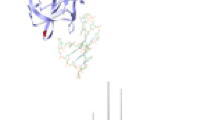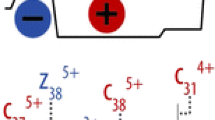Abstract
This communication demonstrates that gentle infrared laser heating can remove unwanted buffer adducts from a gas-phase protein complex without dissociating the complex itself. Specifically, noncovalent complexes of the oligopeptide-binding protein, OppA, bound to either (Ala)3 or LysTrpLys were electrosprayed from aqueous buffer solution into a 9.4 tesla Fourier transform ion cyclotron resonance mass spectrometer. In addition to the intact complexes, several additional buffer adduct species were produced under the conditions of the experiment. Irradiation of the trapped ion population with a continuous-wave infrared CO2 laser at relatively low power (2.5 W) for 1 s dissociated the buffer adducts but retained the intact protein:peptide complexes. Adduct-free complex(es) were then readily identified, and signal-to-noise ratio also increased by an order of magnitude because the same number of protein ions are distributed over fewer species. Higher IR power (5 W for 1 s) dissociated the adduct-free complex(es) without internal fragmentation. The present in-trap clean-up technique may prove especially useful for identifying and screening the combinatorial library ligands most strongly bound to a receptor in the gas phase.
Similar content being viewed by others
References
Lorenz, S. A.; Maziarz, E. P. I.; Wood, T. D. Electrospray ionization Fourier transform mass spectrometry of macromolecules: The first decade. Appl. Spectrosc. 1999, 53, 18A-36A.
Hendrickson, C. L.; Emmett, M. R. Electrospray ionization Fourier transform ion cyclotron resonance mass spectrometry. Annu. Rev. Phys. Chem. 1999, 50, 517–536.
Marshall, A. G.; Guan, S. Advantages of high magnetic field for FT-ICR mass spectrometry. Rapid Commun. Mass Spectrom. 1996, 10, 1819–1823.
Marshall, A. G.; Hendrickson, C. L.; Jackson, G. S. Fourier transform ion cyclotron resonance mass spectrometry: A primer. Mass Spectrom. Rev. 1998, 17, 1–35.
Kelleher, N. L.; Senko, M. W.; Siegel, M. M.; McLafferty, F. W. Unit resolution mass spectra of 112 kDa molecules with 3 Da accuracy. J. Am. Soc. Mass Spectrom. 1997, 8, 380–383.
Little, D. P.; Speir, J. P.; Senko, M. W.; O’Cornnor, P. B.; McLafferty, F. W. Infrared multiphoton dissociation of large multiply-charged ions for biomolecule sequencing. Anal. Chem. 1994, 66, 2809–2815.
Little, D. P.; McLafferty, F. W. Infrared photodissociation of non-covalent adducts of electrosprayed nucleotide ions. J. Am. Soc. Mass Spectrom. 1996, 7, 209–210.
Speir, J. P.; Senko, M. W.; Little, D. P.; Loo, J. A.; McLafferty, F. W. High-resolution tandem mass spectra of 37–67 kDa proteins. J. Mass Spectrom. 1995, 30, 39–42.
Fridriksson, E. K.; Baird, B.; McLafferty, F. W. Electrospray mass spectra from protein electroeluted from sodium dodecylsulfate polyacrylamide gel electrophoresis gels. J. Am. Soc. Mass Spectrom. 1999, 10, 453–555.
Pasa-Tolic, L.; Bruce, J. E.; Lei, P. Q.; Anderson, G. A.; Smith, R. D. In-trap cleanup of proteins from electrospray ionization using soft sustained off-resonance irradiation with Fourier transform ion cyclotron resonance mass spectrometry. Anal. Chem. 1998, 70, 405–408.
Bruce, J. E.; Smith, V. F.; Liu, C.; Randall, L. L.; Smith, R. D. The observation of chaperone-ligand noncovalent complexes with electrospray ionization mass spectrometry. Protein Sci. 1998, 7, 1180–1185.
Senko, M. W.; Hendrickson, C. L.; Emmett, M. R.; Shi, S. D.-H.; Marshall, A. G. External accumulation of ions for enhanced electrospray ionization Fourier transform ion cyclotron resonance mass spectrometry. J. Am. Soc. Mass Spectrom. 1997, 8, 970–976.
Senko, M. W.; Hendrickson, C. L.; Pasa-Tolic, L.; Marto, J. A.; White, F. M.; Guan, S.; Marshall, A. G. Electrospray ionization FT-ICR mass spectrometry at 9.4 tesla. Rapid Commun. Mass Spectrom. 1996, 10, 1824–1828.
Emmett, M. R.; White, F. M.; Hendrickson, C. L.; Shi, S. D.-H.; Marshall, A. G. Application of micro-electrospray liquid chromatography techniques to FT-ICR MS to enable high sensitivity biological analysis. J. Am. Soc. Mass Spectrom. 1998, 9, 333–340.
Emmett, M. R.; Caprioli, R. M. Micro-electrospray mass spectrometry: Ultra-high-sensitivity analysis of peptides and proteins. J. Am. Soc. Mass Spectrom. 1994, 5, 605–613.
Tame, J. R. H.; Murshudov, G. N.; Dodson, E. J.; Neil, T. K.; Dodson, G. G.; Higgins, C. F.; Wilkinson, A. J. The structural basis of sequence-independent peptide binding by OppA protein. Science 1994, 264, 1578–1581.
Rostom, A. A.; Tame, J. R. H.; Ladbury, J. E.; Robinson, C. V. Specificity and interactions of the protein OppA: Partitioning solvent binding effects using mass spectrometry. J. Mol. Biol. 2000, 296, 269–279.
Cheng, X.; Chen, R.; Bruce, J. E.; Schwartz, B. L.; Anderson, G. A.; Hofstadler, S. A.; Gale, G. C.; Smith, R. D. Using electrospray ionization FTICR mass spectrometry to study competitive binding of inhibitors to carbonic anhydrase. J. Am. Chem. Soc. 1995, 117, 8859–8860.
Dunbar, R. C.; McMahon, T. B. Activation of unimolecular reactions by ambient blackbody radiation. Science 1998, 279, 194–197.
Williams, E. R. Tandem FTMS of large biomolecules. Anal. Chem. 1998, 70, 179A-185A.
Freitas, M. A.; Hendrickson, C. L.; Marshall, A. G. Gas phase activation energy for unimolecular dissociation of biomolecular ions determined by focused radiation for gaseous multiphoton energy transfer (FRAGMENT). Rapid Commun. Mass Spectrom. 1999, 13, 1639–1642.
Author information
Authors and Affiliations
Corresponding author
Additional information
Member of the Department of Chemistry, Florida State University, Tallahassee, FL.
Rights and permissions
About this article
Cite this article
Freitas, M.A., Hendrickson, C.L., Marshall, A.G. et al. Competitive binding to the oligopeptide binding protein, OppA: In-trap cleanup in an fourier transform ion cyclotron resonance mass spectrometer. J. Am. Soc. Spectrom. 11, 1023–1026 (2000). https://doi.org/10.1016/S1044-0305(00)00180-X
Received:
Revised:
Accepted:
Issue Date:
DOI: https://doi.org/10.1016/S1044-0305(00)00180-X




